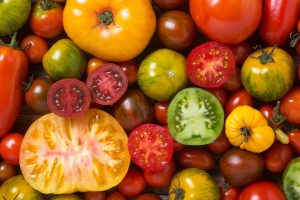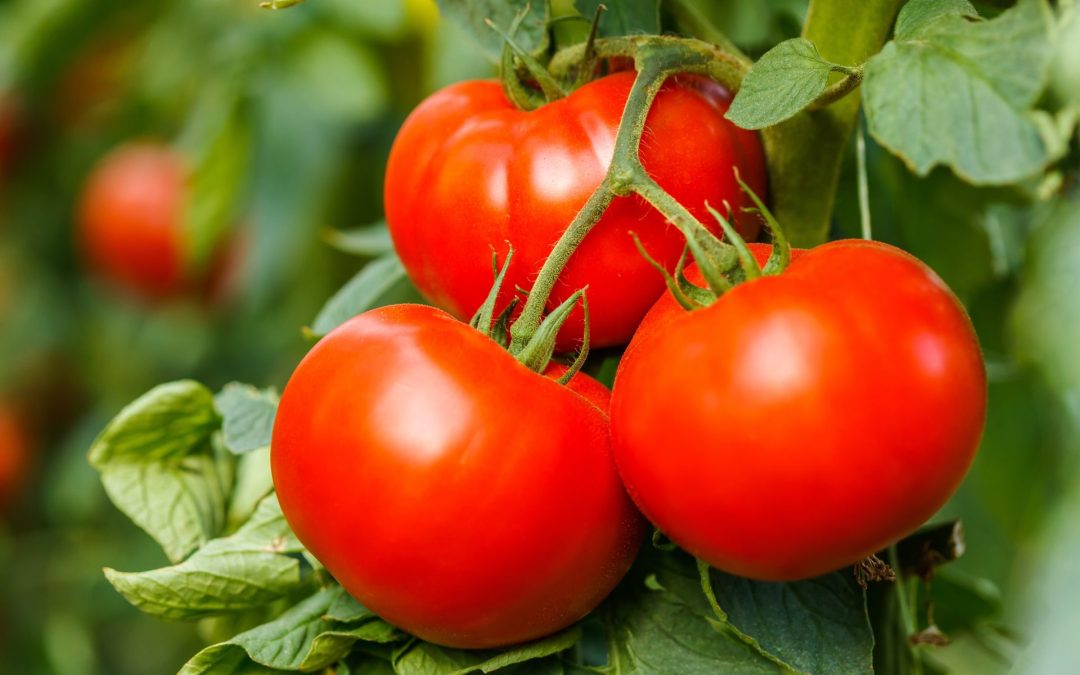Tomato terms you will need to know.
Determinate and Indeterminate refer to a tomato’s growth habit.
Determinate tomato plants tend to be more compact. They grow to a certain height, then flower and set all their fruit at the same time. The harvest period is short which is fine as these are the tomatoes used for sauces, pastes, and soups.
Indeterminate tomato plants continue to grow and produce fruit all season. Making them the perfect choice for supplying a steady supply of fresh fruit for salads and sandwiches all season long.
Heirloom refers to heritage.
Heirloom tomato varieties have been passed down through the generations. They have been grown without cross breeding for many years. Varieties are open-pollinated. Meaning you can save the seeds from the fruit, plant them and expect them to grow into new tomato plants. These are not your supermarket varieties.
Tomato Types
Paste/Plum Tomato – These are determinate plants, the fruit tends to have thicker walls, meaty flesh, and very few seeds. Making them perfect for sauces and soups. There are many different varieties out there and it really is all about your taste preferences.
To name a few favorites – Roma, San Marzano, Black Prince, Amish Prince, and Paisano
Slicing Tomato – These are indeterminate plants. They come in all sizes with meaty flesh an assorted flavors. They provide fresh fruit all season long to enjoy on salads and sandwiches or just by themselves.
To name a few of the most popular – Brandywine, Beefsteak, Cherokee Purple, Oregon Spring, Moskovich, Early Girl, Carbon, Celebrity, Paul Robeson, and many others
Cherry/Grape Tomato – The least fussy to grow of all tomato types. Most of these plants are indeterminate providing and abundance of sweet little snacks all season, they range from the size of a thumbnail to golf ball size. They make perfect additions to any salad, pasta dish, as snacks direct from the vine, and are great to use in salsas.
Lots of favorites in this category, but here are a few – Sungold, Sweet Million, Chocolate Cherry, Yellow Pear, Isis Candy, Oregon Cherry.

Tomato Planting and Care Instructions
As Spring brings glimpses of the sun, we get excited to get our garden started. Tomatoes are one of the most popular veggies to grow. They can be grown in small spaces and can be plucked right off the vine and added to any dish. Making them convenient and rewarding.
Where and When to Plant
We recommend planting tomato starts rather than beginning from seed. The season can be short in our region, starts provide a significant advantage to getting your garden started. Our garden center has an excellent selection of all types to choose from.
Tomatoes need warmth to grow, they cannot take frost. Plant tomato starts in late Spring to early Summer when the days and nights do not get below 60 degrees.
Choose a sunny spot that receives 6-8 hours of sunlight each day. The amount of sunlight they receive really does affect the flavor of fruit.
Regardless of whether you opt for planting in the ground or in containers, ensuring adequate support for your tomato plants is crucial. A variety of tomato support options are available, all serving the purpose of keeping your tomatoes well-supported and elevated from the ground.
Give your tomatoes room to grow, indeterminate tomatoes need to be about 3 feet apart while the determinate varieties tend to be more compact and need only 2 feet. Be sure to follow the planting instructions that come with each start.
When planting directly in the ground, be sure to incorporate high-quality organic garden compost or aged manure into the soil mix. For container gardening, your containers should be at least 24″ in diameter. Be sure to use high quality organic potting soil.
Adding lime and a starting fertilizer to the bottom of the hole before planting will help to raise the PH, increase calcium, and boost the intake of nutrients.
When planting tomato starts you should plan the start deeper than the soil line, bury about two thirds of the stem in soil. Tomatoes will grow roots from the stem and make your tomato very sturdy. This only works on tomatoes. Never use this method on other veggies.
Add a layer of mulch to help keep moisture in the ground.
Watering and Fertilizing Tomatoes.
Once planted, be sure to water the plants well to settle them in.
Tomatoes need consistent watering to prevent cracked skin and blossom end rot. When the top of the soil is dry to about one inch it’s time to water deeply. Watering in the morning is the most effective time as plants are more receptive to moisture.
Tomatoes are big eaters and should be fed regularly with an organic fertilizer designed specifically for tomatoes such as Espoma Tomato tone. Follow the instructions on the package for quantities and frequencies.
Harvesting Tomatoes.
From flower to full size fruit takes about 30-40 days depending on variety.
When the tomato reaches its desired ripeness, it will exhibit the vibrant color characteristic of its variety, such as red, purple, orange, or yellow, and will yield slightly to gentle pressure. It is important not to wait until it is soft.
Harvesting at the “Breaker Stage”, when the fruit is about halfway ripe, and allowing it to ripen off the vine will not diminish its flavor, quality, or nutritional value. Early harvesting can ease the burden on plants and lower the likelihood of fruit cracking.
Harvesting in the afternoon is best. The warmth of the afternoon will help enhance the flavor and aromas.
Do not store tomatoes in the refrigerator. The cooler temperatures diminish the flavor and slow down the ripening process. Tomatoes should be consumed or processed within 4-7 days.
Many gardeners have their own tried and true tips they have used for growing tomatoes, below is a list of our favorites.
- Side dress with crushed eggshells or add while planting to add much needed calcium.
- Add a pinch of Epsom salt when planting to increase root and cell development. It also helps to prevent blossom end rot.
- Sid dress with liquid seaweed, fish emulsion, or compost tea to give extra nutrients.
- Add two uncoated aspirins to the hole at planting time or dissolve them into a gallon of water then spray the young plants. This builds the plants’ immune system to better fight off early attacks of diseases and pests.
- Plant basil or borage near your tomato to prevent hornworms and enhance the taste.
- Withhold water for 3-4 days before harvesting. Tomatoes will be more flavorful.
- Cut the bottom leaves off plants to improve circulation and prevent disease.
- Red mulch increases the tomato harvest. the color reflects into the leaves which causes the plant to produce protein, speeding up the whole growing process. Also works with red peppers, melons, and strawberries.
- In September cut the top of indeterminate plants and stop watering to force energy into the remaining fruit before the end of the season.
- Around October before heavy rains uproot the plant and hang it upside down in the garage or a shed. Tomatoes will continue to ripen on the vine and you could have fresh tomatoes for Thanksgiving.




